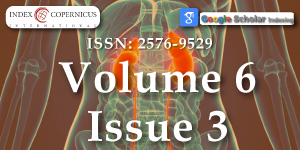An unusual case of corynebacterium gleum peritonitis in peritoneal dialysis
Main Article Content
Article Details
Copyright (c) 2022 Paola N, et al.

This work is licensed under a Creative Commons Attribution 4.0 International License.
The Journal of Clinical Nephrology is committed in making it easier for people to share and build upon the work of others while maintaining consistency with the rules of copyright. In order to use the Open Access paradigm to the maximum extent in true terms as free of charge online access along with usage right, we grant usage rights through the use of specific Creative Commons license.
License: Copyright © 2017 - 2025 |  Open Access by Journal of Clinical Nephrology is licensed under a Creative Commons Attribution 4.0 International License. Based on a work at Heighten Science Publications Inc.
Open Access by Journal of Clinical Nephrology is licensed under a Creative Commons Attribution 4.0 International License. Based on a work at Heighten Science Publications Inc.
With this license, the authors are allowed that after publishing with the journal, they can share their research by posting a free draft copy of their article to any repository or website.
Compliance 'CC BY' license helps in:
| Permission to read and download | ✓ |
| Permission to display in a repository | ✓ |
| Permission to translate | ✓ |
| Commercial uses of manuscript | ✓ |
'CC' stands for Creative Commons license. 'BY' symbolizes that users have provided attribution to the creator that the published manuscripts can be used or shared. This license allows for redistribution, commercial and non-commercial, as long as it is passed along unchanged and in whole, with credit to the author.
Please take in notification that Creative Commons user licenses are non-revocable. We recommend authors to check if their funding body requires a specific license.
Vandamme P, Bernardet J, Segers P, Kersters K, Holmes B. New perspectives in the classification of the Flavobacteria: description of Chryseobacterium gen. nov., Bergeyella gen. nov., and Empedobacter nom. rev." International Journal of Systematic and Evolutionary Microbiology. 1994; 44:827-831.
Parte AC. List of prokaryotic names with standing in nomenclature: Chryseobacterium. 2017. http://www.bacterio.net/chryseobacterium.html
Kirby JT, Sader HS, Walsh TR, Jones RN. Antimicrobial susceptibility and epidemiology of a worldwide collection of Chryseobacterium spp: report from the SENTRY Antimicrobial Surveillance Program (1997-2001). J Clin Microbiol. 2004 Jan;42(1):445-8. doi: 10.1128/JCM.42.1.445-448.2004. PMID: 14715802; PMCID: PMC321713.
Lin JN, Lai CH, Yang CH, Huang YH. Differences in Clinical Manifestations, Antimicrobial Susceptibility Patterns, and Mutations of Fluoroquinolone Target Genes between Chryseobacterium gleum and Chryseobacterium indologenes. Antimicrob Agents Chemother. 2019 Apr 25;63(5):e02256-18. doi: 10.1128/AAC.02256-18. PMID: 30782983; PMCID: PMC6496096.
Garg S, Appannanavar SB, Mohan B, Taneja N. Pyonephrosis due to Chryseobacterium gleum: a first case report. Indian J Med Microbiol. 2015 Apr-Jun;33(2):311-3. doi: 10.4103/0255-0857.154894. PMID: 25865994.
Wimm W, Allen S, Janda W. Organisms that are non motile and oxidase-positive. Komeman's color atlas and textbook of diagnostic microbiology 6th ed, Lippincott Williams and Wilkins, Philadelphia, 2006; 345-353.
Ozcan N, Dal T, Tekin A, Kelekci S, Can S, Ezin O, Kandemir I, Gul K. Is Chryseobacterium indologenes a shunt-lover bacterium? A case report and review of the literature. Infez Med. 2013 Dec;21(4):312-6. PMID: 24335463.
Arouna O, Deluca F, Camara M, Fall B, Fall B, Ba Diallo A, Docquier JD, Mboup S. Chryseobacterium gleum in a man with prostatectomy in Senegal: a case report and review of the literature. J Med Case Rep. 2017 Apr 24;11(1):118. doi: 10.1186/s13256-017-1269-4. PMID: 28438192; PMCID: PMC5402668.
Singhal L, Gupta V, Mehta V, Singla N, Janmeja AK, Chander J. Sepsis due to Chryseobacteriumgleum in a Diabetic Patient with Chronich Obstructive Pulmonary Disease: a Case Report and Mini Review. Jpn J Infect Dis. 2017; 70: 687-688.
Virok DP, Ábrók M, Szél B, Tajti Z, Mader K, Urbán E, Tálosi G. Chryseobacterium gleum - a novel bacterium species detected in neonatal respiratory tract infections. J Matern Fetal Neonatal Med. 2014 Dec;27(18):1926-9. doi: 10.3109/14767058.2014.880881. Epub 2014 Feb 3. PMID: 24410052.
Bellais S, Naas T, Nordmann P. Genetic and biochemical characterization of CGB-1, an Ambler class B carbapenem-hydrolyzing beta-lactamase from Chryseobacterium gleum. Antimicrob Agents Chemother. 2002 Sep;46(9):2791-6. doi: 10.1128/AAC.46.9.2791-2796.2002. PMID: 12183230; PMCID: PMC127440.
Schreckenberger PC, Daneshvar MI, Hollis DG. Non-fermentative gram-negative rods. Manual of Clinical Microbiology 9th ed (Murray PR, Pfaller MA, Labdry ML, Jorgensen JH, Baron EJ, Eds), 2007; 791-794.
Chiu CW, Li MC, Ko WC, Li CW, Chen PL, Chang CM, Lee NY, Lee CC. Clinical impact of Gram-negative nonfermenters on adults with community-onset bacteremia in the emergency department. J Microbiol Immunol Infect. 2015 Feb;48(1):92-100. doi: 10.1016/j.jmii.2013.08.004. Epub 2013 Sep 21. PMID: 24060496.
Vidhi J, Nayami AFAH, Tasneem S, ChinmoySahum Malay G, Kashi NP. Simultaneous isolation of Chryseobacteriumgleum from India. J M M Case report. 2017; 4(10).
Ramya TG, Baby S, Das P. Chryseobacteriumgleum urinary tract infection. Genes Rev. 2015; 10: 50-52.
Lo HH, Chang SM. Identification, characterization, and biofilm formation of clinical Chryseobacterium gleum isolates. Diagn Microbiol Infect Dis. 2014 Jul;79(3):298-302. doi: 10.1016/j.diagmicrobio.2014.01.027. Epub 2014 Feb 20. PMID: 24796989.
Mohamed R, Eslam MS, Sara AR, Nagwa AS. Antimicrobial Resistance and Second Wave of COVID-19: Will It Impose Management Protocols Deviation? Ann PharmacolToxicol. 2020; 1(1): 1001.
Carvalho TJ, Branco PQ, Martins AR, Gaspar A: Chryseobacteriumindologenes peritonitis in a peritoneal dialysis patient. BMJ Case Report; 2018; 11(1).

